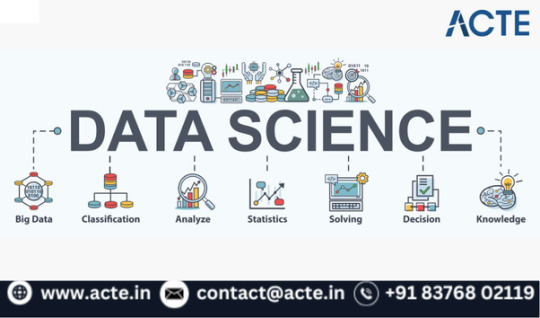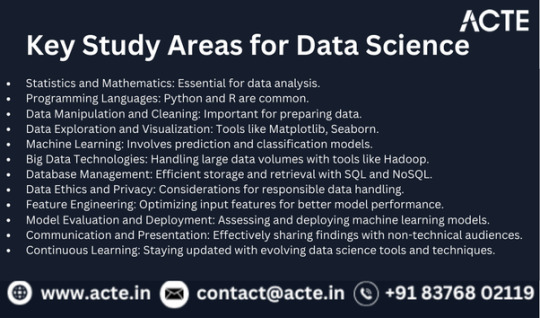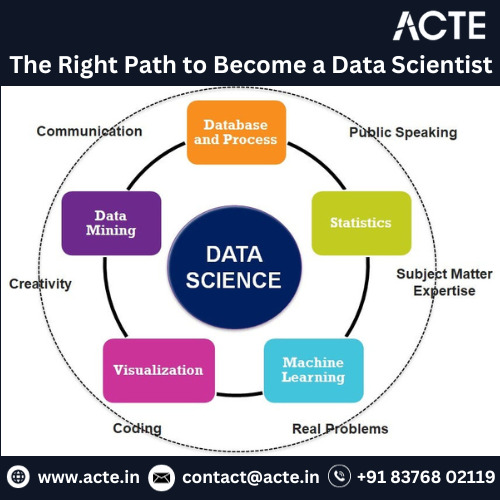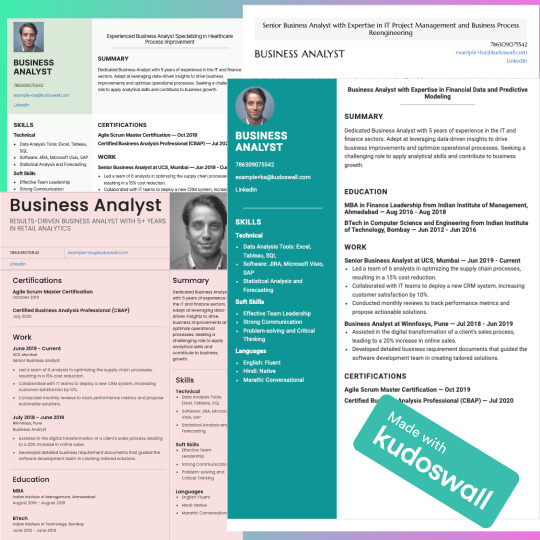#data science tips
Explore tagged Tumblr posts
Text
Key Study Areas For Data Science Beginners : A Simple Guide
Greetings, eager minds! If you’ve found yourself intrigued by the fascinating world of studying data science, you’re in for an enlightening journey. Let’s unravel the intricacies of what delving into data science studies entails, simplifying it with insights from the Best Data Science Training Institute in Bangalore.

Data Science Basics: Definition and Key Study Areas
Data science is the utilization of scientific methods to extract insights from diverse data types, ranging from numbers and text to images and videos. The data can be categorized as structured (organized in tables) or unstructured (comprising text documents or images). Key areas of study include:
Statistics and Mathematics: Crucial for effective data analysis.
Programming Languages: Proficiency in Python and R is common.
Data Manipulation and Cleaning: Important for preparing data for analysis.
Data Exploration and Visualization: Utilizing tools like Matplotlib and Seaborn.
Machine Learning: Involves creating prediction and classification models.
Big Data Technologies: Handling large volumes of data using tools like Hadoop.
Database Management: Efficient storage and retrieval using SQL and NoSQL databases.
Data Ethics and Privacy: Considerations for responsible data handling.
Feature Engineering: Optimizing input features to enhance model performance.
Model Evaluation and Deployment: Assessing and deploying machine learning models.
Communication and Presentation: Effectively conveying findings to non-technical audiences.
Continuous Learning: Staying updated with evolving data science tools and techniques.

Data Scientist’s Journey:
Formal Education: For a comprehensive understanding of data science, consider enrolling in a Data Science course in Bangalore. Such courses offer certifications and job placement opportunities, available both online and offline.
Hands-On Projects: Apply acquired knowledge in practical scenarios to gain real-world experience.
In conclusion, the study of data science is an exhilarating adventure marked by continuous learning, exploration, and an unending pursuit of knowledge. Whether you’re passionate about unraveling the mysteries concealed in data or shaping a future driven by insights, the journey of a data scientist is one of perpetual discovery. Are you ready to embark on your data adventure? The world of data science eagerly awaits your exploration!
I trust I’ve addressed your queries successfully. If not, please feel free to share your thoughts in the comments. I am always open to learning more.
If you find my response helpful, be sure to follow me on Quora and give it an upvote to inspire more content about Data Science. Thank you for investing your valuable time and upvotes here. Have an outstanding day!
0 notes
Text
youtube
How To Learn Math for Machine Learning FAST (Even With Zero Math Background)
I dropped out of high school and managed to became an Applied Scientist at Amazon by self-learning math (and other ML skills). In this video I'll show you exactly how I did it, sharing the resources and study techniques that worked for me, along with practical advice on what math you actually need (and don't need) to break into machine learning and data science.
#How To Learn Math for Machine Learning#machine learning#free education#education#youtube#technology#educate yourselves#educate yourself#tips and tricks#software engineering#data science#artificial intelligence#data analytics#data science course#math#mathematics#Youtube
21 notes
·
View notes
Text
I’ve just enrolled in an undergrad class at my university in data science / coding. It is the first time I’ve done any kind coding. It’s also been almost four years since I was in undergrad myself, so I’m pretty nervous for the exam.
Does anyone have any study tips, particularly for data science / coding, which they would be willing to share? This topic is so different from anything I’ve ever done before I’m feeling pretty out of my depth.
#gradblr#phd#student#student life#studyblr#school#study tips#advice#coding#data science#programming#how to study
74 notes
·
View notes
Text
"From Passion to Profession: Steps to Enter the Tech Industry"
How to Break into the Tech World: Your Comprehensive Guide
In today’s fast-paced digital landscape, the tech industry is thriving and full of opportunities. Whether you’re a student, a career changer, or someone passionate about technology, you may be wondering, “How do I get into the tech world?” This guide will provide you with actionable steps, resources, and insights to help you successfully navigate your journey.
Understanding the Tech Landscape
Before you start, it's essential to understand the various sectors within the tech industry. Key areas include:
Software Development: Designing and building applications and systems.
Data Science: Analyzing data to support decision-making.
Cybersecurity: Safeguarding systems and networks from digital threats.
Product Management: Overseeing the development and delivery of tech products.
User Experience (UX) Design: Focusing on the usability and overall experience of tech products.
Identifying your interests will help you choose the right path.
Step 1: Assess Your Interests and Skills
Begin your journey by evaluating your interests and existing skills. Consider the following questions:
What areas of technology excite me the most?
Do I prefer coding, data analysis, design, or project management?
What transferable skills do I already possess?
This self-assessment will help clarify your direction in the tech field.
Step 2: Gain Relevant Education and Skills
Formal Education
While a degree isn’t always necessary, it can be beneficial, especially for roles in software engineering or data science. Options include:
Computer Science Degree: Provides a strong foundation in programming and system design.
Coding Bootcamps: Intensive programs that teach practical skills quickly.
Online Courses: Platforms like Coursera, edX, and Udacity offer courses in various tech fields.
Self-Learning and Online Resources
The tech industry evolves rapidly, making self-learning crucial. Explore resources like:
FreeCodeCamp: Offers free coding tutorials and projects.
Kaggle: A platform for data science practice and competitions.
YouTube: Channels dedicated to tutorials on coding, design, and more.
Certifications
Certifications can enhance your credentials. Consider options like:
AWS Certified Solutions Architect: Valuable for cloud computing roles.
Certified Information Systems Security Professional (CISSP): Great for cybersecurity.
Google Analytics Certification: Useful for data-driven positions.
Step 3: Build a Portfolio
A strong portfolio showcases your skills and projects. Here’s how to create one:
For Developers
GitHub: Share your code and contributions to open-source projects.
Personal Website: Create a site to display your projects, skills, and resume.
For Designers
Design Portfolio: Use platforms like Behance or Dribbble to showcase your work.
Case Studies: Document your design process and outcomes.
For Data Professionals
Data Projects: Analyze public datasets and share your findings.
Blogging: Write about your data analysis and insights on a personal blog.
Step 4: Network in the Tech Community
Networking is vital for success in tech. Here are some strategies:
Attend Meetups and Conferences
Search for local tech meetups or conferences. Websites like Meetup.com and Eventbrite can help you find relevant events, providing opportunities to meet professionals and learn from experts.
Join Online Communities
Engage in online forums and communities. Use platforms like:
LinkedIn: Connect with industry professionals and share insights.
Twitter: Follow tech influencers and participate in discussions.
Reddit: Subreddits like r/learnprogramming and r/datascience offer valuable advice and support.
Seek Mentorship
Finding a mentor can greatly benefit your journey. Reach out to experienced professionals in your field and ask for guidance.
Step 5: Gain Practical Experience
Hands-on experience is often more valuable than formal education. Here’s how to gain it:
Internships
Apply for internships, even if they are unpaid. They offer exposure to real-world projects and networking opportunities.
Freelancing
Consider freelancing to build your portfolio and gain experience. Platforms like Upwork and Fiverr can connect you with clients.
Contribute to Open Source
Engaging in open-source projects can enhance your skills and visibility. Many projects on GitHub are looking for contributors.
Step 6: Prepare for Job Applications
Crafting Your Resume
Tailor your resume to highlight relevant skills and experiences. Align it with the job description for each application.
Writing a Cover Letter
A compelling cover letter can set you apart. Highlight your passion for technology and what you can contribute.
Practice Interviewing
Prepare for technical interviews by practicing coding challenges on platforms like LeetCode or HackerRank. For non-technical roles, rehearse common behavioral questions.
Step 7: Stay Updated and Keep Learning
The tech world is ever-evolving, making it crucial to stay current. Subscribe to industry newsletters, follow tech blogs, and continue learning through online courses.
Follow Industry Trends
Stay informed about emerging technologies and trends in your field. Resources like TechCrunch, Wired, and industry-specific blogs can provide valuable insights.
Continuous Learning
Dedicate time each week for learning. Whether through new courses, reading, or personal projects, ongoing education is essential for long-term success.
Conclusion
Breaking into the tech world may seem daunting, but with the right approach and commitment, it’s entirely possible. By assessing your interests, acquiring relevant skills, building a portfolio, networking, gaining practical experience, preparing for job applications, and committing to lifelong learning, you’ll be well on your way to a rewarding career in technology.
Embrace the journey, stay curious, and connect with the tech community. The tech world is vast and filled with possibilities, and your adventure is just beginning. Take that first step today and unlock the doors to your future in technology!
contact Infoemation wensite: https://agileseen.com/how-to-get-to-tech-world/ Phone: 01722-326809 Email: [email protected]
#tech career#how to get into tech#technology jobs#software development#data science#cybersecurity#product management#UX design#tech education#networking in tech#internships#freelancing#open source contribution#tech skills#continuous learning#job application tips
9 notes
·
View notes
Text

due to New scientific research in the medical field,
Doctors now recommend that the average healthy person should take 2 to 7 computers with their meals per day.
#much better than those damned apples#science#data#nasa#research#help me im exploding#physics#apples#doctors#health & fitness#health tips#health insurance#computer#healthcare#mental wellness#misinformation#correct information
3 notes
·
View notes
Text
What is the Internet of Things (iot)?
The Internet of Things (IoT) is a network of physical devices, vehicles, home appliances, and other objects embedded with electronics, software, sensors, and connectivity. These devices can collect and exchange data using the internet. Imagine a world where your refrigerator orders groceries when it's running low, your thermostat adjusts the temperature based on your location, and your car can drive itself. This is the power of the internet of things (iot).
At WikiGlitz, we're passionate about exploring the endless possibilities of IoT. From smart homes to industrial automation, we'll keep you informed about the latest trends and innovations. Whether you're a tech enthusiast or a business professional, our content will help you understand the impact of IoT on your daily life and industry.
If you like to know more about IoT in the Automobile Industry: Driving Incredible Innovation then check out our in-depth article. Visit our official blog for the latest updates. Our Official Blog Site:https://wikiglitz.co/
#virtual reality#augmented reality#blockchain technology#blockchain#ai technology#technology#technology tips#chatgpt#gemini ai#cloud computing#machine learning#latest technology in artificial intelligence#future of artificial intelligence#renewable energy and sustainability#biotechnology and genetic engineering#quantum computing#virtual and augmented reality (vr/ar)#internet of things (iot)#blockchain and cryptocurrency#artificial intelligence#brain-computer interfaces#robotics#cybersecurity#big data and analytics#space exploration#materials science#nanotechnology#artificial general intelligence (agi)#brain-computer interfaces (bcis)
1 note
·
View note
Text
How to Successfully Build a Professional Portfolio for Data Science Jobs (2025 Edition)
In 2025, your data science portfolio is your loudest resume. With thousands of bootcamp grads and certificate holders entering the field each year, what sets successful candidates apart isn’t just what they’ve learned — it’s what they’ve built. If you’re a job seeker aiming to stand out in the competitive data science job market, a strong, strategic portfolio is non-negotiable. Let’s break down…
#best data science tools 2025#data science portfolio 2025#github for data scientists#how to build data science projects#kaggle portfolio tips
0 notes
Text
Data Science Job Interviews | Data Science Interviews Tips & Tricks
Want to ace your upcoming Data Science job interview? Join Nick Singh, author of the best-selling book, Ace the Data Science … source
0 notes
Text
The Right Path To Become A Data Scientist : A Beginner Guide
Embarking on the journey to become a data scientist may seem like entering a mysterious world, but fear not! Here’s a guide to illuminate your path, featuring the renowned ACTE Technologies Best Data Science Course. Let’s break down the steps to become a data scientist in simpler terms:

Step 1: Lay the Foundation Start by understanding the basics.
Data Awareness: Learn about different types of data like numbers, text, and images. Know the difference between structured and unstructured data.
Tool Mastery: Get familiar with programming languages like Python or R, as they’ll be your coding companions in the data science world.
Step 2: Develop Your Magical Toolkit Dive into foundational elements that make you a data wizard.
Math Mastery: You don’t need to be a math genius, but having a good understanding of statistics, linear algebra, and calculus will enhance your analytical skills.
Step 3: Master the Art of Machine Learning Machine learning is your trusty sidekick in making sense of data.
Understanding Machine Learning: Think of it as a wise mentor guiding your analytical endeavors.
Key Concepts: Get to know supervised and unsupervised learning, regression, classification — these are the tools for predictive analytics.
Step 4: Taming Big Data Enter the world of big data, where vast amounts of information await your expertise.
Big Data Principles: Understand the three Vs — Volume, Velocity, and Variety.
Tools: Get familiar with Hadoop and Spark, your allies in navigating big data challenges.

Step 5: Real-World Applications Test your skills in practical projects.
Individual Projects: Start small projects aligned with your interests, applying your skills in real-world scenarios.
Kaggle Competitions: Join these competitive arenas to strengthen and validate your skills.
Step 6: Never Stop Learning In the ever-evolving landscape of data science, continuous learning is key.
Literature Exploration: Dive into blogs and books to gain insights from seasoned practitioners.
Enroll in Courses: ACTE Technologies offers a comprehensive Data Science course in Bangalore, covering programming, statistical analysis, and machine learning. The course provides certifications and job placement opportunities, a valuable step in your journey.
Step 7: Join the Data Science Community Networking and collaboration are crucial for growth.
Networking: Engage with fellow learners on platforms like GitHub and Stack Overflow.
Your journey to becoming a data scientist involves learning, exploration, and practical application. With a solid foundation, continuous curiosity, and a reliable companion like the ACTE Technologies course, you’re on your way to mastering the art of data science. May your path be filled with discovery and success!
0 notes
Text
12 Tips for Writing a Compelling Proposal for a Data Science Thesis we will help you with 12 essential tips for your research paper.Your paper will not only meet academic standards but also captivate the interest of your readers.
0 notes
Text
Start Strong: Beginner Data Science Courses to Launch Your Career in Canada
Start a profession with Sai Data Science! Join for beginners Data Science courses in Canada and you'll have access to unlimited chances in the technology sector.
#data science course in canada#learn data science online#data science course in edmonton#data visualization tips and techniques
0 notes
Text
Why You Should Start A/B Testing Your Resume (and How to Do It Right)

We all know how nerve-wracking it can be to make changes to your career path. After all, your resume is one of the most important tools in your job search. But what if you could take a calculated risk that could significantly improve your chances of landing that dream job? That’s where A/B testing comes in—a method that lets you experiment with different versions of your resume, cover letter, and even your headline to see what resonates best with hiring managers.
What is A/B Testing?
Borrowed from the world of marketing, A/B testing is all about experimenting. You create two or more versions of your resume and job application materials and test them to see which one performs better. This process helps you optimize your resume to get more responses, interviews, and ultimately, job offers.
Here’s how you can apply A/B testing to your job search:
1. Create Different Versions of Your Resume:
Generic Resume: This is your baseline. A resume that isn’t tailored to a specific job but could work for multiple opportunities.
Industry-Specific Resume: This version is customized for a particular industry or job type, emphasizing the skills and experience that are highly valued in that sector.
Fully Customized Resume: Tailored to the specific job you’re applying for, this resume reflects the job description and highlights the most relevant aspects of your experience.
2. Single-Page vs. Multipage Resumes:
Wondering if your one-page resume is too limiting? Try a multipage resume that allows you to dive deeper into your accomplishments. But make sure the first page captures attention—if it’s not compelling, hiring managers might not make it to page two.
3. Test Resume Headlines and Cover Letters:
Resume headlines are your first opportunity to make an impression. Experiment with different headlines—one highlighting your skills, another emphasizing your years of experience—and see which one gets more callbacks.
Similarly, test out different cover letters. A generic letter can be contrasted with a tailored one that speaks directly to the company’s needs or culture.
When Should You Try A/B Testing?
This technique works best if you’re passively looking for a job or considering a change in the next six months. It gives you the time and space to test different approaches without the pressure of urgently needing a new role. On the other hand, if you’re in a hurry to find a job, A/B testing might slow you down.
Why A/B Testing is a Game-Changer:
It allows you to make data-driven decisions about what works in your job search.
You’ll learn which version of your resume resonates best with hiring managers.
It takes the guesswork out of resume writing.
Leverage Technology for A/B Testing:
Tools like KudosWall’s AI Resume Builder and Cover Letter Generator can make A/B testing easier. With just a few clicks, you can create multiple versions of your resume and cover letter, helping you customize your applications for different opportunities. You can also store and track different versions, making the testing process more manageable.
Ready to Experiment?
A/B testing your resume and job application materials can seem like a calculated risk, but when done right, it can be the key to landing more interviews and offers. Why settle for a resume that might not work when you can fine-tune it to perfection?
#CareerTips#ResumeWriting#JobSearch#ResumeOptimization#CareerChange#AIResumeBuilder#CoverLetterTips#KudosWall#ai resume#resume writing tips#fresher#career advice#job#data science#a/b testing#resume#business analyst
1 note
·
View note
Text
Future of Artificial Intelligence
The Future of Artificial Intelligence: A Glimpse into Tomorrow
Artificial intelligence (AI) is rapidly transforming industries and reshaping our world. As WikiGlitz explores the future of AI, we delve into the exciting possibilities and challenges that lie ahead.
From self-driving cars and intelligent personal assistants to advanced medical diagnostics and personalized learning experiences, AI has the potential to revolutionize countless aspects of our lives. However, ethical considerations, job displacement, and the potential for misuse are important factors to consider.
As AI continues to evolve, WikiGlitz will keep you informed about the latest breakthroughs, applications, and implications for the future. Stay tuned for more insights into the exciting world of artificial intelligence. If you like to know more about the AI Breakthroughs: 6 Amazing Advances You Need to Know then check out our in-depth article. Visit our official blog for the latest updates.

#virtual reality#augmented reality#blockchain technology#blockchain#ai technology#technology#technology tips#chatgpt#gemini ai#cloud computing#machine learning#latest technology in artificial intelligence#future of artificial intelligence#renewable energy and sustainability#biotechnology and genetic engineering#quantum computing#virtual and augmented reality (vr/ar)#internet of things (iot)#blockchain and cryptocurrency#artificial intelligence#brain-computer interfaces#robotics#cybersecurity#big data and analytics#space exploration#materials science#nanotechnology#artificial general intelligence (agi)#brain-computer interfaces (bcis)
1 note
·
View note
Text
IT and Non IT Training in Nepal
If you are ready to build your career in IT and Non-IT training, enroll in any of various training in Nepal!
According to my research, I found best HR training provided by UpSkills Nepal with many different IT and Non It courses!
Most Of top Non IT courses are:
Digital marketing training in Nepal
HR training in Nepal
SEO training in Nepal
Accounting training in Nepal
Graphics design training in Nepal
Diploma in digital marketing in Nepal
Most important IT courses are:
Cybersecurity courses in Nepal
Data science traning in Nepal
AI training in Nepal
DevOps training in Nepal
Python traning in Nepal
UI/UX training in Nepal
#professional hr training#hr training#digital marketing company#digital marketing#digital marketing training#seo training#seo marketing#diploma courses#devops#devops training#cybersecurity#cybersecurity training#data science training#ui ux design#python course#python tutorial#accounting tips
0 notes
Text
Data Science Careers: What You Need to Successfully Know Now in 2025
In a world where data is the new oil, data science remains one of the most lucrative, future-proof, and dynamic careers in tech. But in 2025, the landscape has evolved: artificial intelligence has become mainstream, tools are more automated, and expectations for data professionals have shifted. If you’re considering entering or growing in the field, this guide explains exactly what you need to…
#AI in data science#data portfolio tips#data science careers 2025#machine learning jobs 2025#Python data science skills
0 notes
Text
How to Explain Data Science Projects in Interviews? 3 Tips for Crafting Clear and Impactful Answers!
3 Tips for Project-based Questions in Data Science interviews | How to Talk About Previous Projects Why The S.T.A.R Method … source
0 notes